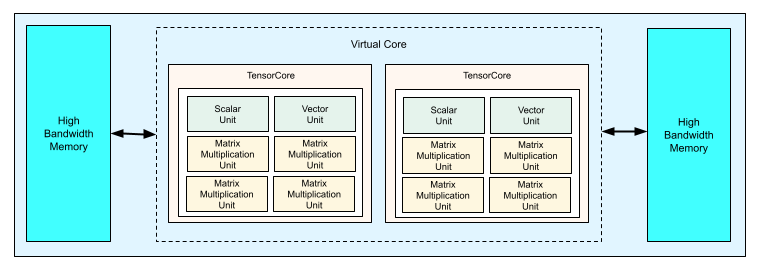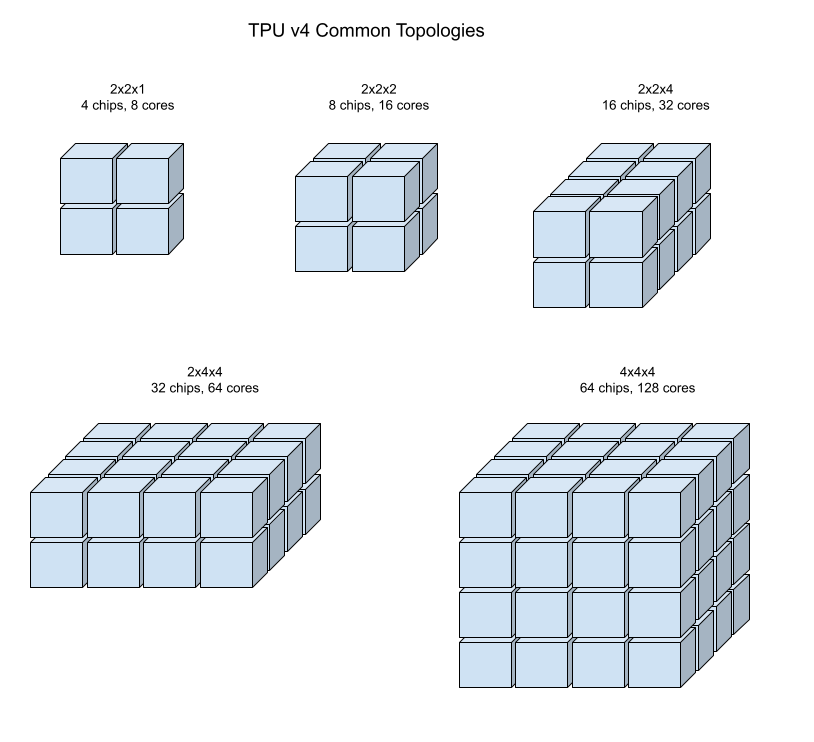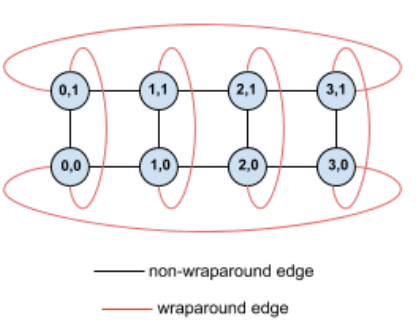TPU v4
This document describes the architecture and supported configurations of Cloud TPU v4.
System architecture
Each TPU v4 chip contains two TensorCores. Each TensorCore has four matrix-multiply units (MXUs), a vector unit, and a scalar unit. The following table shows the key specifications for a v4 TPU Pod.
| Key specifications | v4 Pod values |
|---|---|
| Peak compute per chip | 275 teraflops (bf16 or int8) |
| HBM2 capacity and bandwidth | 32 GiB, 1200 GBps |
| Measured min/mean/max power | 90/170/192 W |
| TPU Pod size | 4096 chips |
| Interconnect topology | 3D mesh |
| Peak compute per Pod | 1.1 exaflops (bf16 or int8) |
| All-reduce bandwidth per Pod | 1.1 PB/s |
| Bisection bandwidth per Pod | 24 TB/s |
The following diagram illustrates a TPU v4 chip.

For more information about architectural details and performance characteristics for TPU v4, see TPU v4: An Optically Reconfigurable Supercomputer for Machine Learning with Hardware Support for Embeddings.
3D mesh and 3D torus
v4 TPUs have a direct connection to the nearest neighboring chips in 3 dimensions, resulting in a 3D mesh of networking connections. The connections can be configured as a 3D torus on slices where the topology, AxBxC, is either 2A=B=C or 2A=2B=C, where each dimension is a multiple of 4. For example, 4x4x8, 4x8x8, or 12x12x24. In general, the performance of a 3D torus configuration will be better than a 3D mesh configuration. For more information, see Twisted tori topologies.
Performance benefits of TPU v4 over v3
This section shows a memory-efficient way to run a sample training script on TPU v4, as well as the performance improvements for TPU v4 compared to TPU v3.
Memory system
Non Uniform Memory Access (NUMA) is a computer memory architecture for machines that have multiple CPUs. Each CPU has direct access to a block of high-speed memory. A CPU and its memory is called a NUMA node. NUMA nodes are connected to other NUMA nodes that are directly adjacent to each other. A CPU from one NUMA node can access memory in another NUMA node, but this access is slower than accessing memory within a NUMA node.
Software running on a multi-CPU machine can place data needed by a CPU within its NUMA node, increasing memory throughput. For more information about NUMA, see Non Uniform Memory Access on Wikipedia.
You can take advantage of NUMA-locality benefits by binding your training script to NUMA Node 0.
To enable NUMA node binding:
Install the numactl command line tool. numactl lets you run processes with a specific NUMA scheduling or memory placement policy.
$ sudo apt-get update $ sudo apt-get install numactl
Bind your script code to NUMA Node 0. Replace your-training-script with the path to your training script.
$ numactl --cpunodebind=0 python3 your-training-script
Enable NUMA node binding if:
- If your workload has a heavy dependence on CPU workloads (for example, image classification, recommendation workloads) regardless of framework.
- If you are using a TPU runtime version without a -pod suffix (for example,
tpu-vm-tf-2.10.0-v4).
Other memory system differences:
- v4 TPU chips have a unified 32-GiB HBM memory space across the entire chip, enabling better coordination between the two on-chip TensorCores.
- Improved HBM performance using latest memory standards and speeds.
- Improved DMA performance profile with built-in support for high-performance striding at 512B granularities.
TensorCores
- Twice the number of MXUs and a higher clock rate delivering 275 max TFLOPS.
- 2x transposition and permutation bandwidth.
- Load-store memory access model for Common Memory (Cmem).
- Faster MXU weight loading bandwidth and 8-bit mode support to allow lower batch sizes and improved inference latency.
Inter-chip interconnect
Six interconnect links per chip to enable network topologies that have smaller network diameters.
Other
- x16 PCIE gen3 interface to host (direct connect).
- Improved security model.
- Improved energy efficiency.
Configurations
A TPU v4 Pod is composed of 4096 chips interconnected with reconfigurable
high-speed links. TPU v4's flexible networking lets you connect the chips in a
same-sized slice in multiple ways. When you create a TPU slice, you
specify the TPU version and the number of TPU resources you require. When you
create a TPU v4 slice, you can specify its type and size in one of two ways:
AcceleratorType and AccleratorConfig.
Using AcceleratorType
Use AcceleratorType when you are not specifying a topology. To configure v4 TPUs
using AcceleratorType, use the --accelerator-type flag when creating your
TPU slice. Set --accelerator-type to a string that contains the TPU
version and the number of TensorCores you want to use. For example, to create a
v4 slice with 32 TensorCores, you would use --accelerator-type=v4-32.
Use the gcloud compute tpus tpu-vm create
command
to create a v4 TPU slice with 512 TensorCores using the --accelerator-type
flag:
$ gcloud compute tpus tpu-vm create your-tpu-name \ --zone=us-central2-b \ --accelerator-type=v4-512 \ --version=tpu-ubuntu2204-base
The number after the TPU version (v4) specifies the number of TensorCores.
There are two TensorCores in a v4 TPU, so the number of TPU chips
would be 512/2 = 256.
For more information about managing TPUs, see Manage TPUs. For more information about the system architecture of Cloud TPU, see System architecture.
Using AcceleratorConfig
Use AcceleratorConfig when you want to customize the physical topology
of your TPU slice. This is generally required for performance tuning with
slices greater than 256 chips.
To configure v4 TPUs using AcceleratorConfig, use the --type and the
--topology flags. Set --type to the TPU version you want to use and
--topology to the physical arrangement of the TPU chips in the slice.
You specify a TPU topology using a 3-tuple, AxBxC where A<=B<=C and A, B, C are
either all <= 4 or are all integer multiples of 4. The values A, B, and C are
the chip counts in each of the three dimensions. For example, to create a v4
slice with 16 chips, you would set --type=v4 and --topology=2x2x4.
Use the gcloud compute tpus tpu-vm create
command
to create a v4 TPU slice with 128 TPU chips arranged in a 4x4x8 array:
$ gcloud compute tpus tpu-vm create your-tpu-name \ --zone=us-central2-b \ --type=v4 \ --topology=4x4x8 \ --version=tpu-ubuntu2204-base
Topologies where 2A=B=C or 2A=2B=C also have topology variants optimized for all-to-all communication, for example, 4×4×8, 8×8×16, and 12×12×24. These are known as twisted tori topologies.
The following illustrations show some common TPU v4 topologies.

Larger slices can be built from one or more 4x4x4 "cubes" of chips.
For more information about managing TPUs, see Manage TPUs. For more information about the system architecture of Cloud TPU, see System architecture.
Twisted tori topologies
Some v4 3D torus slice shapes have the option to use what is known as a twisted torus topology. For example, two v4 cubes can be arranged as a 4x4x8 slice or 4x4x8_twisted. Twisted topologies offer significantly higher bisection bandwidth. For example, a slice with the 4x4x8_twisted topology provides a 70% theoretical increase in bisection bandwidth over a non-twisted 4x4x8 slice. Increased bisection bandwidth is useful for workloads that use global communication patterns. Twisted topologies can improve performance for most models, with large TPU embedding workloads benefiting the most.
For workloads that use data parallelism as the only parallelism strategy, twisted topologies might perform slightly better. For LLMs, performance using a twisted topology can vary depending on the type of parallelism (DP, MP, etc.). Best practice is to train your LLM with and without a twisted topology to determine which provides the best performance for your model. Some experiments on the FSDP MaxText model have seen 1-2 MFU improvements using a twisted topology.
The primary benefit of twisted topologies is that it transforms an asymmetric torus topology (for example, 4×4×8) into a closely related symmetric topology. The symmetric topology has many benefits:
- Improved load balancing
- Higher bisection bandwidth
- Shorter packet routes
These benefits ultimately translate into improved performance for many global communication patterns.
The TPU software supports twisted tori on slices where the size of each dimension is either equal to or twice the size of the smallest dimension. For example, 4x4x8, 4×8×8, or 12x12x24.
As an example, consider this 4×2 torus topology with TPUs labeled with their (X,Y) coordinates in the slice:
The edges in this topology graph are shown as undirected edges for clarity. In practice, each edge is a bidirectional connection between TPUs. We refer to the edges between one side of this grid and the opposite side as wrap-around edges, as noted in the diagram.

By twisting this topology, we end up a completely symmetric 4×2 twisted torus topology:

All that has changed between this diagram and the previous one is the Y wrap-around edges. Instead of connecting to another TPU with the same X coordinate, they have been shifted to connect to the TPU with coordinate X+2 mod 4.
The same idea generalizes to different dimension sizes and different numbers of dimensions. The resulting network is symmetric, as long as each dimension is equal to or twice the size of the smallest dimension.
See using AcceleratorConfig for details about how to specify a twisted tori configuration when creating a Cloud TPU.
The following table shows the supported twisted topologies and a theoretical increase in bisection bandwidth with them versus untwisted topologies.
| Twisted Topology | Theoretical increase in bisection bandwidth versus a non-twisted torus |
|---|---|
| 4×4×8_twisted | ~70% |
| 8x8x16_twisted | |
| 12×12×24_twisted | |
| 4×8×8_twisted | ~40% |
| 8×16×16_twisted |
TPU v4 topology variants
Some topologies containing the same number of chips can be arranged in different ways. For example, a TPU slice with 512 chips (1024 TensorCores) can be configured using the following topologies: 4x4x32, 4x8x16, or 8x8x8. A TPU slice with 2048 chips (4096 TensorCores) offers even more topology options: 4x4x128, 4x8x64, 4x16x32, and 8x16x16.
The default topology associated with a given chip count is the one that's most similar to a cube. This shape is likely the best choice for data-parallel ML training. Other topologies can be useful for workloads with multiple kinds of parallelism (for example, model and data parallelism, or spatial partitioning of a simulation). These workloads perform best if the topology is matched to the parallelism used. For example, placing 4-way model parallelism on the X dimension and 256-way data parallelism on the Y and Z dimensions matches a 4x16x16 topology.
Models with multiple dimensions of parallelism perform best with their parallelism dimensions mapped to TPU topology dimensions. These are usually data and model parallel large language models (LLMs). For example, for a TPU v4 slice with topology 8x16x16, the TPU topology dimensions are 8, 16 and 16. It is more performant to use 8-way or 16-way model parallelism (mapped to one of the physical TPU topology dimensions). A 4-way model parallelism would be sub-optimal with this topology, since it's not aligned with any of the TPU topology dimensions, but it would be optimal with a 4x16x32 topology on the same number of chips.
TPU v4 configurations consist of two groups, those with topologies smaller than 64 chips (small topologies) and those with topologies greater than 64 chips (large topologies).
Small v4 topologies
Cloud TPU supports the following TPU v4 slices smaller than 64 chips, a 4x4x4 cube. You can create these small v4 topologies using either their TensorCore-based name (for example, v4-32), or their topology (for example, 2x2x4):
| Name (based on TensorCore count) | Number of chips | Topology |
| v4-8 | 4 | 2x2x1 |
| v4-16 | 8 | 2x2x2 |
| v4-32 | 16 | 2x2x4 |
| v4-64 | 32 | 2x4x4 |
Large v4 topologies
TPU v4 slices are available in increments of 64 chips, with shapes that are
multiples of 4 on all three dimensions. The dimensions must be in
increasing order. Several examples are shown in the following table. A few of
these topologies are "custom" topologies that can only be created using the
--type and --topology flags because there is more than one way to arrange
the chips.
| Name (based on TensorCore count) | Number of chips | Topology |
| v4-128 | 64 | 4x4x4 |
| v4-256 | 128 | 4x4x8 |
| v4-512 | 256 | 4x8x8 |
custom topology: must use the --type and --topology flags |
256 | 4x4x16 |
| v4-1024 | 512 | 8x8x8 |
| v4-1536 | 768 | 8x8x12 |
| v4-2048 | 1024 | 8x8x16 |
custom topology: must use --type and --topology flags |
1024 | 4x16x16 |
| v4-4096 | 2048 | 8x16x16 |
| … | … | … |
